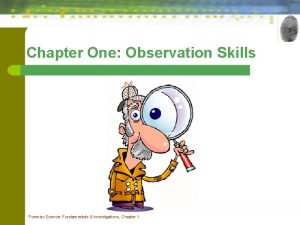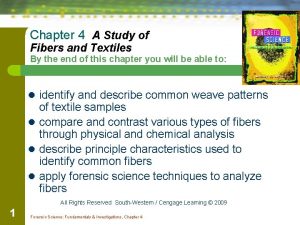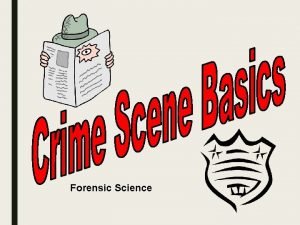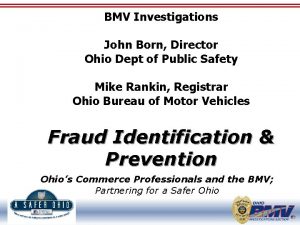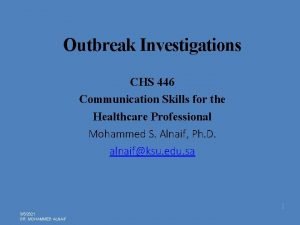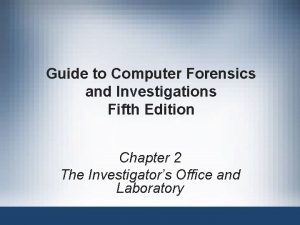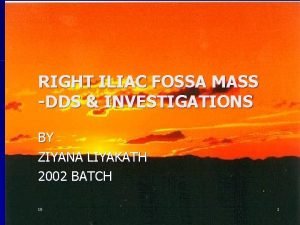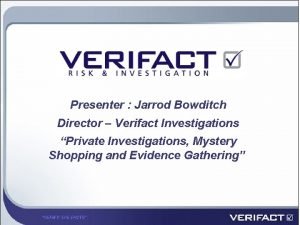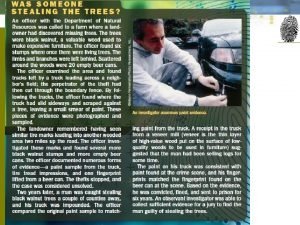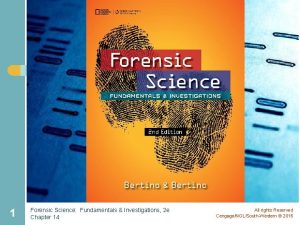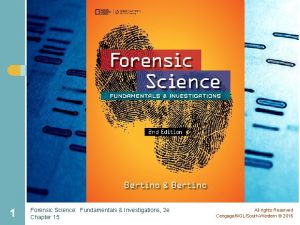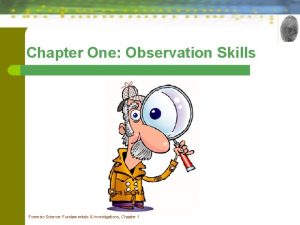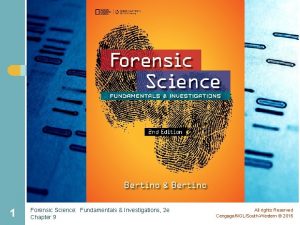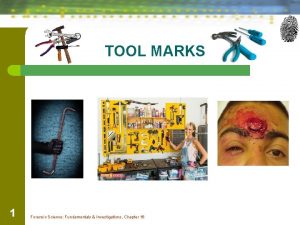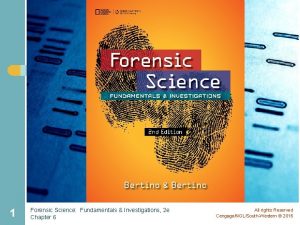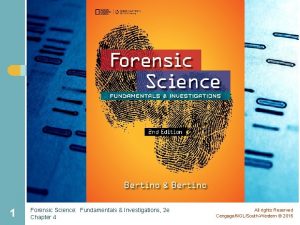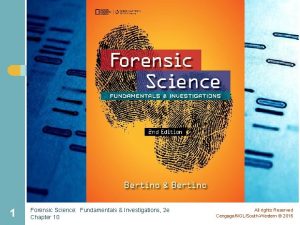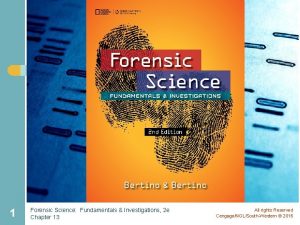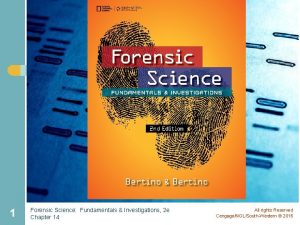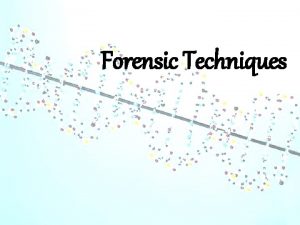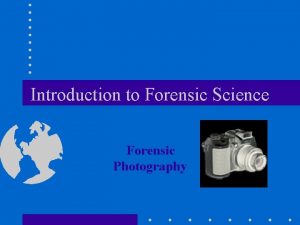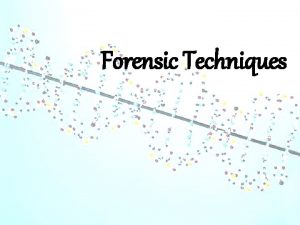1 Forensic Science Fundamentals Investigations 2 e Chapter



























- Slides: 27

1 Forensic Science: Fundamentals & Investigations, 2 e Chapter 9 All rights Reserved Cengage/NGL/South-Western © 2016

Chapter 9 Forensic Toxicology By the end of this chapter you will be able to: 9. 1 Provide examples of drugs, poisons, and toxins. 9. 2 List factors that affect drug toxicity. 9. 3 Describe the role of a toxicologist in analyzing substance evidence. 9. 4 Compare and contrast presumptive testing and confirmatory testing. 2 Forensic Science: Fundamentals & Investigations, 2 e Chapter 9 All rights Reserved Cengage/NGL/South-Western © 2016

Chapter 9 Forensic Toxicology By the end of this chapter you will be able to: 9. 5 Describe how people get exposed to environmental toxins (e. g. , pesticides, carbon monoxide), and describe their effects on the body. 9. 6 Distinguish among the terms tolerance, addiction, dependence, and withdrawal. 9. 7 Relate the signs and symptoms of overdose with a specific substance or combination of substances. 9. 8 Show the relationships between the law, crime, and the use of drugs. 3 Forensic Science: Fundamentals & Investigations, 2 e Chapter 9 All rights Reserved Cengage/NGL/South-Western © 2016

Chapter 9 Vocabulary o o o o 4 addiction controlled substance Controlled Substances Act dependency depressant hallucinogen illegal drug o o o o Forensic Science: Fundamentals & Investigations, 2 e Chapter 9 narcotic poison stimulant tolerance toxicity toxicology toxin All rights Reserved Cengage/NGL/South-Western © 2016

Introduction o Toxicology is the study of substances that can harm a person. • • o A person may be exposed to a substance in any of the ways below: • • • 5 Poisons Toxins Intentionally Accidentally Deliberately Forensic Science: Fundamentals & Investigations, 2 e Chapter 9 All rights Reserved Cengage/NGL/South-Western © 2016

Brief History of Forensic Toxicology o o 6 Socrates is one of the earliest reported victims of poisoning (Hemlock, 399 B. C. ) By the 1600 s, poisoning had become a profession. During the 1800 s, methods of chemical analysis were developed to identify poisons. In 1980, standardized techniques and testing were developed to help determine the cause of death. Forensic Science: Fundamentals & Investigations, 2 e Chapter 9 All rights Reserved Cengage/NGL/South-Western © 2016

Brief History of Forensic Toxicology (continued) o o o 7 In 1959, the FDA was formed. In 1970, Congress passed the Controlled Substances Act. Today, less than one-half of one percent of all homicides result from poisoning. Forensic Science: Fundamentals & Investigations, 2 e Chapter 9 All rights Reserved Cengage/NGL/South-Western © 2016

Brief History of Forensic Toxicology (continued) o 8 In 1978, Bulgarian dissident Georgi Markov was stabbed in the leg with an umbrella armed with a ricin toxin. Forensic Science: Fundamentals & Investigations, 2 e Chapter 9 All rights Reserved Cengage/NGL/South-Western © 2016

Evidence Detection, Collection, and Storage o Evidence may be in the form of: • • • o 9 Pills, powders, liquids Botanical matter (seeds, leaves, mushrooms) Crystals (methamphetamine) Evidence found on clothing, objects, or liquid soaked fabrics Urine, blood, sweat, or saliva Correct packaging of the evidence is important to preserve the evidence and to protect individuals working with the evidence. Forensic Science: Fundamentals & Investigations, 2 e Chapter 9 All rights Reserved Cengage/NGL/South-Western © 2016

Evidence Testing and Reporting of Drugs, Poisons and Toxins o A toxicologist needs to answer three basic questions: 1. What substances are there? (qualitative testing) 2. Might there be any illegal components? 3. How much of each substance is present? (quantitative testing) o 10 Presumptive testing may be performed at the crime scene. Forensic Science: Fundamentals & Investigations, 2 e Chapter 9 All rights Reserved Cengage/NGL/South-Western © 2016

Evidence Testing and Reporting of Drugs, Poisons and Toxins (continued) o o Confirmatory testing is a multistep process that provides a positive identification of the substance. Toxicologists must also distinguish between: • • 11 Acute poisoning Chronic poisoning Forensic Science: Fundamentals & Investigations, 2 e Chapter 9 All rights Reserved Cengage/NGL/South-Western © 2016

12 Forensic Science: Fundamentals & Investigations, 2 e Chapter 9 All rights Reserved Cengage/NGL/South-Western © 2016

Heavy Metals, Gases, Poisons, and Toxins 13 Forensic Science: Fundamentals & Investigations, 2 e Chapter 9 All rights Reserved Cengage/NGL/South-Western © 2016

Lethal Gases and Lethal Injections o Lethal gas chambers • • o American penal systems • o o 14 Nazis during World War II Carbon monoxide from engine exhaust and hydrogen cyanide Hydrogen cyanide Carbon monoxide gas Injections of potassium chloride or sodium pentothal Forensic Science: Fundamentals & Investigations, 2 e Chapter 9 All rights Reserved Cengage/NGL/South-Western © 2016

Pesticides and Herbicides 15 Forensic Science: Fundamentals & Investigations, 2 e Chapter 9 All rights Reserved Cengage/NGL/South-Western © 2016

Toxins o Toxins may be produced by plants or animals. • • 16 Ricin Rattlesnake venom Forensic Science: Fundamentals & Investigations, 2 e Chapter 9 All rights Reserved Cengage/NGL/South-Western © 2016

Drugs and Crime o o o 17 Almost half of the individuals in federal prisons are there because of drug-related offenses. More than $600 billion is spent annually on costs related to crime, lost work productivity, and healthcare because of drug abuse. Continued use of a drug can lead to addiction and dependency. Forensic Science: Fundamentals & Investigations, 2 e Chapter 9 All rights Reserved Cengage/NGL/South-Western © 2016

Five Schedules of Drugs o Schedule I • • o Schedule II • • o Severely restricted medical use, high potential for abuse Ex: Cocaine, methamphetamine, methadone, oxycodone Schedule III • • 18 No medical use, high potential for abuse Ex: Heroine, LSD, peyote, MDMA, bath salts Accepted medical use, moderate potential for abuse, moderate to low risk of dependence Ex: Barbiturates, steroids, ketamine Forensic Science: Fundamentals & Investigations, 2 e Chapter 9 All rights Reserved Cengage/NGL/South-Western © 2016

Five Schedules of Drugs (continued) o Schedule IV • • o Schedule V • • 19 Medical use, low potential for abuse and the risk of dependency Ex: Xanax, Valium, sleeping pills, other tranquilizers Widely used for medical purposes, very low potential for abuse, contains limited quantities of narcotics Ex: Robitussin® AC, Tylenol® with codeine Forensic Science: Fundamentals & Investigations, 2 e Chapter 9 All rights Reserved Cengage/NGL/South-Western © 2016

Illegal Drugs o Hallucinogens • • o Heroine • • o 20 Affect perception, thinking, self-awareness, and emotions Flashbacks may occur long after the drugs wear off Narcotics are addictive, sleep inducing drugs that act as central nervous system depressants and suppress pain. Highly addictive Combining drugs, such as heroin and alcohol, can be fatal. Forensic Science: Fundamentals & Investigations, 2 e Chapter 9 All rights Reserved Cengage/NGL/South-Western © 2016

Illegal Drugs (continued) 21 Forensic Science: Fundamentals & Investigations, 2 e Chapter 9 All rights Reserved Cengage/NGL/South-Western © 2016

Controlled Substances o o o 22 Stimulants Narcotics Depressants Forensic Science: Fundamentals & Investigations, 2 e Chapter 9 All rights Reserved Cengage/NGL/South-Western © 2016

Alcohol o o 23 Alcohol is a central nervous system depressant. The amount of alcohol in a beverage is expressed as a percentage by volume or in proof, which is twice the percentage. A liquor that is 80 proof contains 40% alcohol. Someone with a blood alcohol concentration of. 15 percent will retain alcohol in his or her body for approximately 10 hours. Forensic Science: Fundamentals & Investigations, 2 e Chapter 9 All rights Reserved Cengage/NGL/South-Western © 2016

Anabolic Steroids o Anabolic steroids promote cell and tissue growth and division. • o Negative side effects may include: • • 24 They have a chemical structure similar to testosterone. Acne, increased body hair, and baldness Increased aggression, high blood pressure, high cholesterol levels, impaired fertility in males, blood clotting, kidney and liver cancers, and heart attacks Forensic Science: Fundamentals & Investigations, 2 e Chapter 9 All rights Reserved Cengage/NGL/South-Western © 2016

Summary o o 25 Toxicology is the study of poisons, toxins, drugs, and other substances a person may use for medical, recreational, or criminal purposes. Forensic toxicologists study the harmful effects of these substances on the body, typically after a death. The toxicity of a substance depends on the dose, the duration of exposure, the nature of exposure, interactions with other substances, and the byproducts formed when metabolized. Forensic Science: Fundamentals & Investigations, 2 e Chapter 9 All rights Reserved Cengage/NGL/South-Western © 2016

Summary (continued) o o 26 Exposure to heavy metals, poison gases, other poisons, toxins, or radiation may occur accidentally or as a result of a crime (or punishment) and have harmful or lethal effects on the body. Drugs are classified by their effect on the body as stimulants, depressants, narcotics, hallucinogens, or anabolic steroids; drugs are classified under five schedules created by the 1970 Controlled Substances Act. Forensic Science: Fundamentals & Investigations, 2 e Chapter 9 All rights Reserved Cengage/NGL/South-Western © 2016

Summary (continued) o o o 27 Use of drugs can affect a person’s health, mood, awareness, metabolism, and/or perception of reality. Extended exposure to drugs can lead to tolerance, dependence, addiction, and illness. Drug combinations can have compounding effects and result in accidental death. Forensic Science: Fundamentals & Investigations, 2 e Chapter 9 All rights Reserved Cengage/NGL/South-Western © 2016
 Chapter 6 fingerprints
Chapter 6 fingerprints Forensic anthropologist vs forensic pathologist
Forensic anthropologist vs forensic pathologist Who is this
Who is this Fundamentals of forensic dna typing
Fundamentals of forensic dna typing The golden book of camping
The golden book of camping Nibis ballistics definition
Nibis ballistics definition Chapter 14 forensic anthropology
Chapter 14 forensic anthropology How can we as forensic scientists become better observers
How can we as forensic scientists become better observers What is a textile in forensic science
What is a textile in forensic science Forensic science chapter 1
Forensic science chapter 1 Forensic criminalist
Forensic criminalist Forensic science vocabulary
Forensic science vocabulary Forensic science chapter 1
Forensic science chapter 1 Her favourite subject be english
Her favourite subject be english Why aren t descriptive investigations repeatable
Why aren t descriptive investigations repeatable Nrich maths investigations
Nrich maths investigations Craigslist wayne
Craigslist wayne Guide to computer forensics and investigations
Guide to computer forensics and investigations Statistical average crossword
Statistical average crossword Types of statistical investigation
Types of statistical investigation Toledo bmv heatherdowns
Toledo bmv heatherdowns Observations in scientific method
Observations in scientific method Child protective investigations pasco county
Child protective investigations pasco county Chs investigations
Chs investigations Forensics
Forensics Iliac region
Iliac region Jarrod bowditch
Jarrod bowditch Antenatal investigations
Antenatal investigations







